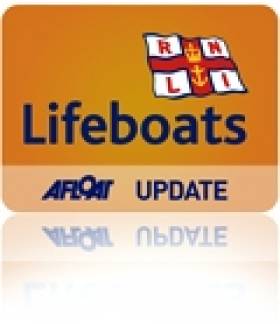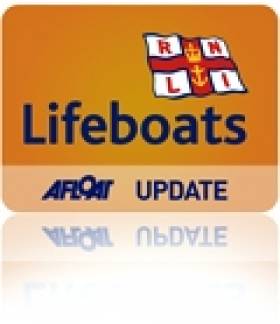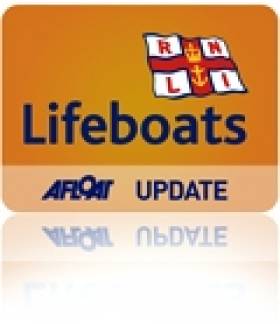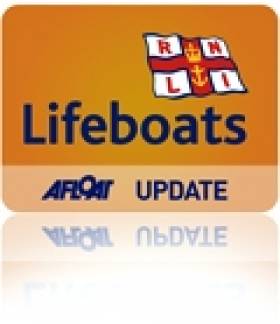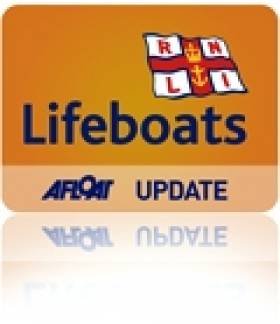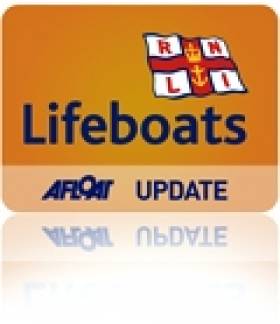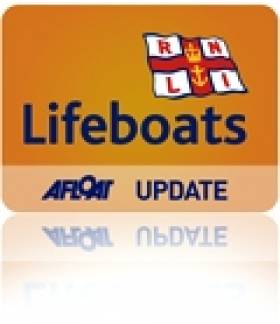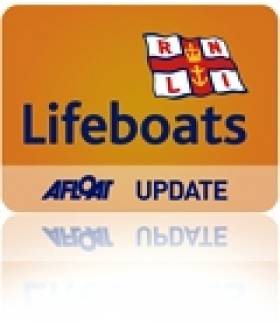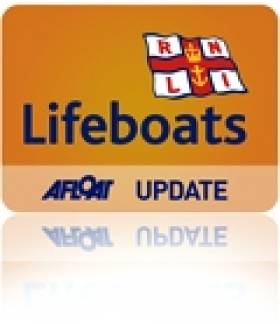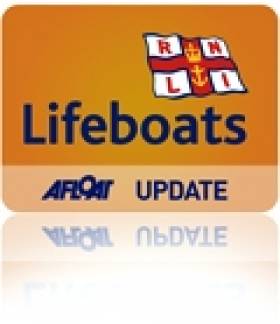Displaying items by tag: Lifeboats
Festive Cheer At RNLI's Dublin Reindeer Run
#RNLI - Nearly 1,000 people from all over Leinster and beyond took part in the annual RNLI Reindeer Run at Marlay Park on Sunday 1 December.
It was a sea of festive red as entrants in the 5K, 10K and Santa Saunter got into the Christmas spirit by wearing a novelty pair of antlers and a special Reindeer Run T-shirt.
Supporting the runners and walkers around the course this year were lifeboat crew from Dublin’s three stations in Howth, Skerries and Dun Laoghaire. From the latter, Damien Payne was joined by colleague Paul Cummins took an extra step by running the 5K in their full RNLI crew kit.
Also mooing the runners was 98FM’s Teena Gates, who led the warm-up sessions with Rookie the Reindeer. Gates also took part in the short Santa Saunter organised for the event’s younger participants before running in the 5K.
As for the winners? It was Longford man Stephen Farrell who was first around the 10K course while Alison Davidson from Dublin took the honours for the ladies. Nicolae Buceanu won the 5K men’s event while Emer Dillon from Arklow was the first of the women to the finish line.
Speaking after the successful day, RNLI community fundraising manager for Leinster Pauline McGann said: "We were thrilled with how the event went and that so many people turned out to support the RNLI. The atmosphere was great, with children and adults all getting into the Christmas spirit and enjoying the different events.
"It was a great way to kick off the festive season while raising vital funds and we would like to thank everyone who took part."
The Marlay Park Reindeer Run was sponsored by Green Property, Haines Fleet and SuperValu Malahide.
Wicklow Lifeboat Aids Fishermen, Courtown Volunteers Recognised
#RNLI - Wicklow RNLI's all-weather lifeboat launched shortly after 12.20pm on Friday 29 November to go to the assistance of a stranded fishing vessel.
The lifeboat crew located a vessel drifting nine miles south east of Wicklow Head after 1pm. The fishing boat, with four crew, had suffered engine failure and was unable to return to port.
The volunteer crew quickly established a towline and the fishing vessel was taken back to Wicklow harbour. It was brought alongside the East pier just before 3pm.
The crew on the callout were coxswain Nick Keogh, mechanic Brendan Copeland, Ciaran Doyle, Brendan Kavanagh, Carol Flahive, Dean Mulvihill and Graham Fitzgerald.
In other lifeboats news, a presentation was made to recently honour many years of service from five Courtown RNLI lifeboat crew members.
Volunteer lifeboat crew members Orla Woods, Nuala Sinnott, Brian Bergin and Paul Woods were all recognised for their many years of dedicated service to the RNLI at an event in Courtown's Taravie Hotel.
Crewmember Fintan O'Donoghue was also presented with a statuette to mark his many years of selfless volunteering.
O'Donoghue is still a very active member of Courtown lifeboat and is now a deputy launch officer and station mechanic.
All Courtown lifeboat crew members are volunteers and give their time freely to save lives at seas.
Two Cancer Survivors Who Sailed Round Ireland Raise €8,255 for the RNLI
Two incredible Limerick men who have both battled cancer have presented the RNLI and two cancer charities with a cheque for €8,255 each after they successfully sailed round Ireland. The two friends Chris Egan and Dave Bevan from Foynes Yacht Club in Limerick decided to take on the daunting challenge when Chris, who had battled cancer, approached his friend Dave, who had huge maritime experience, with the idea of doing a 'Round Ireland Sail'. The attempt became all the more poignant when Dave himself developed cancer a short time later.
The men were joined on the voyage by a former Kilmore Quay RNLI lifeboat crewmember, Gerry Hutton and members of Foynes Yacht club. Between them they successfully completed the challenge, arriving home two months after they set off on the May Bank Holiday weekend. The men and their supporters were raising funds for three charities close to their heart; the RNLI, the Mid-Western Cancer Foundation and the Irish Cancer Society.
The group only took only two short breaks during the attempt. The first was after they reached the Aran Islands off Galway and hit a patch of bad weather; the RNLI lifeboat crew based on Inis Mhór kept an eye on their boat while they went home to wait out the weather before returning to resume their journey. The second was in Cahersiveen, County Kerry to attend family events.
According to the men one of the bonuses of the trip was that it brought them to many of the locations around the coast where the RNLI has lifeboat stations. Dave Bevan also managed to receive his final chemotherapy treatment while on the trip, pulling into Cork and visiting the hospital.
Commenting on their incredible voyage Chris Egan said, "I am delighted we were successful in our round Ireland sail and that we managed to raise nearly €25,000 for three important charities. I class myself as a Mickey Mouse Sunday Sailor and it is a world away from my day job as a postman but it has been one of the greatest experiences of my life. The warm welcome we received around the coast, especially when we reached RNLI lifeboat stations, was tremendous.
I also can't thank enough all the generous people who sponsored us and raised funds, from a bag pack to a raffle, people really dug deep for charity. I've already put the RNLI on notice that we'd love to do it again, but this time going anti-clockwise. You never know.'
Receiving the cheque on behalf of the RNLI at Foynes Yacht club was Beverley Callendar, a volunteer souvenir secretary with the charity. Beverley had kept in touch with the sailors and helped where she could with introductions to RNLI volunteers on the coast. Beverley added, 'I have huge admiration for Chris and Dave. The fact that after battling serious illness they would then turn their thoughts to raising money for charity is incredible. The funds they raised will help Irish volunteer lifeboat crewmembers in their work saving lives at sea both in training and through their equipment. On behalf of the RNLI I would like to personally thank Chris and Dave for their generosity.'
Anyone interested in learning more about the trip can look at photographs from Chris and Dave's adventures on their Facebook page: Sail Against Cancer Ireland.
Search Resumes For Lobsterman Missing Off Wexford Coast
#RNLI - The search for a lobster fisherman missing off the Wexford coast was set to resume this morning after it was suspended at sunset last night.
RNLI lifeboats from Kilmore Quay, Rosslare and Fethard launched yesterday afternoon (Monday 25 November) to search for the fisherman after his boat was found empty at Shoal Rock, at the bottom of Great Saltee Island off Wexford.
The alarm was raised at 12.50pm after another fisherman in the area noticed that the boat had been stationary in the water for some time.
Kilmore Quay RNLI co-ordinated the sea search, and along with lifeboats from Rosslare and Fethard they were joined by up to 25 local boats in the search for the missing man.
The search was also joined by the Irish Coast Guard helicopter and divers from the Naval Service, who were taken to the scene onboard the Rosslare lifeboat.
Weather conditions yesterday were described as good and visibility was excellent.
'Safety Sunday' With Lifeboat Launches In Wicklow And Skerries
#RNLI - Wicklow RNLI went to the assistance of three fishermen whose 36ft fishing boat suffered engine failure near Wicklow Head yesterday afternoon (Sunday 24 November).
The alarm was raised after the crew were unable to start the engine and were concerned about the possibility of their boat being swept ashore.
The Wicklow RNLI all-weather lifeboat launched at 2.30pm under the command of coxswain Ciaran Doyle, followed a few minutes later by the inshore lifeboat.
The drifting fishing vessel was located 10 minutes later about half a mile east of Brides Head. Weather conditions at the time had the wind at a northerly Force 3, with a slight sea state and good visibility.
A towline was quickly established and the stricken vessel was towed back to Wicklow by the lifeboat before 3pm with no further incident.
Much earlier in the day, the Skerries RNLI volunteer crew were tasked to investigate reports of a person in the water in Balbriggan Harbour in the small hours of the morning.
The crew were paged at 12:30am and the lifeboat was launched shortly after with helms Joe May, Conor Walsh and David Knight and crew member Peter Kennedy on board.
There was a Force 3 to 4 northwesterly wind blowing at the time and the sea state was moderate.
The lifeboat proceeded directly to Balbriggan Harbour where it was quickly determined that the person had been taken from the water and was receiving first aid treatment by members of Dublin Fire Brigade and the HSE ambulance service.
The lifeboat then proceeded to carry out a thorough search of the harbour to ensure that there was nobody else in the water before returning to station.
Speaking afterwards, helm Joe May said: "Our volunteer crew are on call 24 hours a day, 365 days of the year. The pager can go off at any time but we are always ready to respond."
Book Charting History Of Arklow RNLI Launches This Friday
#RNLI - Olympic gold medallist and son of Arklow, Ronnie Delaney, will be on hand this Friday 22 November for the official launch of a new book that charts the history of the Wexford town's lifeboat station.
As previously reported on Afloat.ie, To the Banks & Beyond was written by local historian Jim Rees, who spent a number of years putting together the project that recounts the history of Arklow RNLI from 1826 to the present day in words and pictures.
A limited run of hardback editions has already sold out, but the paperback is still available priced at €15 (plus P&P) via Arklow RNLI Fundraising or the lifeboat station shop at 0402 32850 or [email protected].
Courtown Lifeboat Assists Stranded Angling Vessel
#RNLI - The Courtown RNLI lifeboat was launched yesterday afternoon (Sunday 17 November) to assist and tow a small 19ft angling boat.
The angling boat had suffered engine failure and required a tow to Courtown Harbour.
The lifeboat, with volunteer crew Glen Deacon, David Switzer and Áine Stafford, went to the assistance of the angling boat and towed it to safety without incident.
Dun Laoghaire Lifeboat Crewman Will Don Full Kit For Reindeer Run
#RNLI - Dun Laoghaire RNLI volunteer crewmember Damien Payne has vowed to complete the popular Reindeer Run charity event on the 5km course in his full RNLI crew kit.
Payne hopes to both fundraise for the lifesaving charity and to show people the kit that the money they raise can buy.
Originally from Cork but now works in Dublin with a healthcare company, Payne has been a volunteer at the busy Dun Laoghaire RNLI lifeboat station for two years.
The lifeboat kit he will be running in consists of the distinctive yellow oil skin jacket and dungarees with the red RNLI lifejacket that all crew must wear when they go to sea.
The only concession he's making is to leave the steel-capped yellow wellies at the starting line and to don a pair of trainers instead. An RNLI lifejacket costs €420 and the special yellow wellies cost €50.
Payne explained his reasons for taking part in the run wearing his lifeboat kit: “I want to wear the RNLI lifeboat crew kit to show people where the funds they raise are going and how vital our equipment is in the work we do.
"One of the first callouts I took part in was late one Friday afternoon to four children who were cut off on a sandbank by the incoming tide in Sandymount. They had no lifejackets and they couldn’t swim.
"When we recovered the children onto our lifeboat we learned it was the first time they had been on a boat and they had no knowledge of water safety."
Payne added: "The equipment and training we use in the RNLI is essential to the work we do and without we would not have been able to bring those children to safety."
As previously reported on Afloat.ie, year's Reindeer Runs are being held on Sunday 1 December at Marlay Park in Dublin and on Sunday 24 November at Fota House and Gardens in Carrigtwohill, Co Cork with a 5km and 10km walk or run, and a 1km Santa Saunter for younger participants.
Registration is now open and costs €10 for the saunter, €21 for the 5km and €23 for the 10km run or walk. There are also family and group rates available. All participants receive a limited edition RNLI Reindeer Run t-shirt and a pair of antlers.
Further information and registration details are available at rnli.org/reindeer or by emailing [email protected] for Dublin or [email protected] for Cork.
Clifden RNLI Names New Atlantic 85 Lifeboat
#RNLI - Clifden RNLI officially named its new Atlantic 85 lifeboat, Joyce King, at its station in the Connemara coastal town of Clifden in a special ceremony yesterday (Saturday 9 November).
John Coyle, chairman of the Irish council of the RNLI, accepted the lifeboat on behalf of the institution before handing her over into the care of Clifden Lifeboat Station.
Coyle paid tribute to the donor John Charles King, who had generously funded the lifeboat through a gift left in his will.
King - who hailed from Lincolnshire in England - funded the lifeboat, which has been in service in Clifden since June, in memory of his wife Joyce.
Jackie O’Grady, chair of the Clifden RNLI lifeboat management group and a former honorary secretary at the station, then officially named the lifeboat during the ceremony.
The new state-of-the-art Atlantic 85 lifeboat, at 8,4m in length and weighing 1.8 tonnes, was introduced into the RNLI fleet in 2005. Improvements on its predecessor include a faster top speed of 35 knots, radar, provision for a fourth crew member and more space for survivors.
Since the new lifeboat went into service in Clifden, it has had seven call-outs and 20 people have been brought to safety.
Clifden RNLI lifeboat operations manager John Brittain said the naming ceremony and service of dedication was a special occasion in the history of the lifeboat station, adding that the volunteer crew was grateful to King for his generous legacy.
He said the RNLI could not operate its lifeboats without the dedication of volunteer lifeboat crew.
"The 37 men and women currently on our crew in Clifden give 100% at all times. Their commitment and on-going attendance for training both here and at the lifeboat college means that they are highly proficient in the operation of their lifeboats.
"Further testament of the dedication of the crew is their knowledge that they may risk their own lives in the service of others. There is nothing greater that a person could offer and they deserve nothing less than the best lifeboat, equipment and training that money can buy."
Brittain went on to pay tribute to the vital support provided by the volunteers who support the crew.
"However, the lifeboat crew and I are only one part of this station. I must mention our operation team, supporters and fundraisers who volunteer their time and efforts and do so much for Clifden RNLI. These are people of all ages who give what time and money they can – thank you."
The RNLI established a lifeboat station in Clifden in early 1988 when a C-class lifeboat was put on service for one season’s evaluation. The following year Clifden RNLI became fully operational as a summer season only lifeboat station.
In 1992 part of a building used for housing the lifeboat was demolished and a new purpose-built building was constructed in order to provide adequate facilities for the lifeboat and crew. As well as providing an area for the C-class lifeboat and launching vehicle, it included a workshop and crew facilities.
In 1997, an Atlantic 21 lifeboat was placed on service and a new boathouse for the lifeboat and a tractor was completed in August 1998. A new Atlantic 75 B-class lifeboat was placed on service in 1999 and remained stationed until June when it was replaced by the Atlantic 85.
Fast, manoeuvrable and reliable, the B-class operates in rough weather conditions, capable in daylight up to force seven and at night, to force six winds. The new lifeboat, an Atlantic 85, is the latest version of the B-class.
A crowd of well-wishers turned up to see the lifeboat officially named with a bottle of champagne poured over the side of the boat before it launched at the end of the ceremony.
Clifden RNLI lifeboat crew member David Barry welcomed guests and opened proceedings while Lavinia Joyce from the Clifden RNLI fundraising branch delivered the vote of thanks. Father James Ronayne and Reverend Stan Evans lead the service of dedication.
Arklow Lifeboat Crew Comes To Aid Of 'Sammy The Seal'
#RNLI - Arklow RNLI’s volunteers were involved in an unusual rescue yesterday (5 November) at Arklow Harbour's boat slipway when they came to the aid of a seal pup.
Lifeboat crew were alerted to the marine mammal's plight by a member of the fishing community who had spotted the seal in an exhausted condition near Arklow lifeboat station.
On arriving at the scene, Arklow RNLI lifeboat volunteer press officer Mark Corcoran made contact with the Irish Whale & Dolphin Group and the Irish Seal Sanctuary to ascertain the best course of action to assist the seal pup. Also on scene was Tommy Heffernan from Avondale Vets.
Arklow RNLI lifeboat crew members including Scott Heaney and other members of the public assisted by keeping onlookers and curious dogs away from the distressed seal, who was determined to be tired and dehydrates following consultations with experts.
It was then decided that it would be best to remove the baby seal - named Sammy by the crew - to the safety of Avondale Vets and, once he was stabilised, to move the seal onward to the Irish Seal Sanctuary.
The pup is now being cared for by the Irish Seal Sanctuary and will enjoy a diet of fresh fish until it reaches a healthy weight and can be released back into the wild.
"It was an amazing experience to get so close to a seal," said Corcoran after the call-out. "They’re really fantastic creatures, and it’s not an everyday occurrence.
"Thanks to the teamwork demonstrated by the different groups involved, the story had a happy ending and I’m really pleased that we could help."


























